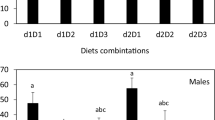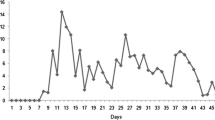Abstract
Diadromus pulchellus, a monophagous parasitoid of the leek moth, Acrolepiopsis assectella, a specialist of plants in the Allium genus, was raised on four series of chrysalids coming from four diets: leek leaves (LL), an artificial diet with (D + L) or without (D − L) leek powder, and an artificial diet plus 1% methyl-cysteinesulfoxide, a precursor of characteristic sulfur volatiles (D + P). Various behavioral and physiological responses by the parent parasitoids and the progeny were studied. No differences were observed in behavior among the four series. The higher precursor concentration observed in LL and in D + P than in D + L and D − L was responsible for a lower emergence ratio and higher egg production in LL and D + P. The consequences of these variations are discussed in relation to narrowness of the tritrophic system. The fact that sulfur volatiles favorable to behavior arise from nonvolatile sulfur precursors, having negative effects on physiology, can also contribute to the maintenance of the system.
Similar content being viewed by others
REFERENCES
Al Rouz, H., and Thibout, E. 1989. Les substances végétales non volatiles et leur effet phagostimulant sur les larves de cinquième stade de la teigne du poireau Acrolepiopsis assectella. Repord. Nutr. Dev. 26:161-170.
Arnault, C. 1979. Influence de substances de la plante-hôte sur le développement larvaire d'Acrolepiopsis assectella (Lepidoptera, Acrolepiidae) en alimentation artificielle. Entomol. Exp. Appl. 25:64-74.
Arnault, C. 1982. Conséquences de l'alimentation artificielle sur le développement larvaire de la teigne du poireau, Acrolepiopsis assectella. Entomol. Exp. Appl. 32:116-122.
Arnault, C., and Loewenbruck, C. 1986. Influence of host plant and larval diet on ovarian productivity in Acrolepiopsis assectella Z. (Lepidoptera: Acrolepiidae). Experientia 42:448-450.
Auger, J., and Thibout, E. 1981. Emission par le poireau Allium porrum de thiosulfinates actifs sur la teigne du poireau, Acrolepiopsis assectella Z. (Lepidoptera). C.R. Acad. Sci. Paris 292:217-220.
Auger, J., Lecomte, C., and Thibout, E. 1990. Origin of the kairomones in the leek-moth (Acrolepiopsis assectella, Lep.) frass. Possible pathway from methylthio to propylthio compounds. J. Chem. Ecol. 16:1743-1750.
Auger, J., Mellouki, F., Vannereau, A., Boscher, J., Cosson, L., and Mandon, N. 1993. Analysis of Allium sulfur amino acids by HPLC after derivatization. Chromatographia 36:347-350.
Barbosa, P., Saunders, J. A., Kemper, J., Trumble, R., Olechno, J., and Martinat, P. 1986. Plant allelochemicals and insect parasitoids. Effects of nicotine on Cotesia congregata (Say) (Hymenoptera: Braconidae) and Hyposoter annulipes (Cresson) (Hymenoptera: Ichneumonidae). J. Chem. Ecol. 12:1319-1328.
Bekkaoui, A., and Thibout, E. 1992. Rôle de substances cuticulaires non volatiles d'Acrolepiopsis assectella (Lep.: Hyponomeutoïdea) dans la reconnaissance de l'hôte par les parasitoïdes Diadromus pulchellus et D. collaris (Hym.: Ichneumonidae). Entomophaga 37:627-639.
Bekkaoui, A., and Thibout, E. 1993. Role of the cocoon of Acrolepiopsis assectella (Lep., Hyponomeutoidea) in host recognition by the parasitoid Diadromus pulchellus (Hym., Ichneumonidae). Entomophaga 38:101-113.
Bentz, J. A., and Barbosa, P. 1992. Effect of dietary nicotine and partial starvation of tobacco hornworm, Manduca sexta E., on the survival and development of the parasitoid Cotesia congregata. Entomol. Exp. Appl. 65:241-245.
Bidlingmeyer, B. A., Cohen, S. A., and Tarvin, T. L. 1984. Rapid analysis of amino acids using pre-column derivatization. J. Chromatogr. 336:93-104.
Campbell, B. C., and Duffey, S. S. 1979. Tomatine and parasitic wasps: Potential incompatibility of plant antibiosis with biological control. Science 205:700-702.
Elzen, G. W., Williams, H. J., and Vinson, S. B. 1986. Wind tunnel flight responses by hymenopterous parasitoid Campoletis sonorensis to cotton cultivars and lines. Entomol. Exp. Appl. 42:285-290.
English-Loeb, G. M., Brody, A. K., and Karban, R. 1993. Host-plant-mediated interactions between a generalist folivore and its tachinid parasitoid. J. Anim. Ecol. 62:465-471.
Ferary, S., Thibout, E., and Auger, J. 1996. Direct analysis of odors emitted by freshly cut Allium using combined high-performance liquid chromatography and mass spectrometry. Rapid Commun. Mass Spectrom. 10:1327-1332.
Ferary, S., Keller, J., Boscher, J., and Auger, J. 1998. Fast narrow-bore HPLC-DAD analysis of biologically active thiosulfinates obtained without solvent from wild Allium species. Biomed. Chromatogr. 12:104-106.
Fox, L. R., Letourneau, P. K., Eisenbach, J., and Van Nouhuys, S. 1990. Parasitism rates and sex ratio of a parasitoid wasp: Effects of herbivore and plant quality. Oecologia 83:414-419.
Fraenkel, G. S. 1959. The raison d'être of secondary plant substances. Science 129:1466-1470.
Godray, H. C. J. 1994. Parasitoids. Behavioral and Evolutionary Ecology. Princeton University Press, Princeton, New Jersey.
Greenblatt, J. A., and Barbosa, P. 1981. Effects of host's diet in two pupal parasitoids of the gypsy moth: Brachymeria intermedia (Neer) and Coccygominus turionellae (L.). J. Appl. Ecol. 18:1-10.
Gunasena, G. H., Vinson, S. B., Williams, H. J., and Stipanovic, R. D. 1989. Development and survival of the endoparasitoid Campoletis sonorensis (Hymenoptera: Ichneumonidae) reared from gossypol-exposed Heliothis virescens (F.) (Lepidoptera: Noctuidae). Environ. Entomol. 18:886-891.
Hare, J. D., and Luck, R. F. 1991. Indirect effects of citrus cultivars on life history parameters of a parasitic wasp. Ecology 72:1576-1585.
Idris, A. B., and Grafius, E. 1996. Effects of wild and cultivated host plants on oviposition, survival, and development of Diamondback moth (Lepidoptera: Plutellidae) and its parasitoid Diadegma insulare (Hymenoptera: Ichneumonidae). Environ. Entomol. 25:825-833.
Kauffman, W. C., and Kennedy, G. G. 1989. Toxicity of allelochemicals from wild insect-resistant tomato Lycopersicon hirsutum f. glabratum to Campoletis sonorensis, a parasitoid of Heliothis zea. J. Chem. Ecol. 15:2051-2060.
Kalmes, R. 1984. Examen des problèmes posés par la sympatrie sur Acrolepiopsis assectella (Lèpidoptère Hyponomeutoïde) dans le sud-est de la France, des deux hyménoptères ichneumonides Diadromus collaris et Diadromus pulchellus. PhD dissertation. University of Tours, Tours, France.
Lancaster, J. E., Dommisse, E. M., and Shaw, M. L. 1988. Production of flavour precurosrs [S-alk(en)yl-cysteine-sulphoxides] in photomixotrophic callus of garlic. Phytochemistry 27:2123-2124.
Lecomte, C., and Thibout, E. 1981. Attraction d'Acrolepiopsis assectella, en olfactomètre, par des substances allélochimiques volatiles d'Allium porrum. Entomol. Exp. Appl. 30:293-300.
Lecomte, C., and Thibout, E. 1986. Analyse, dans deux types d'olfactomètres, du comportement de quête des femelles de Diadromus pulchellus en présence d'odeurs du phytophage-hôte et du végétal attaqué ou non. Entomophaga 31:69-78.
McAuslane, H. J., Vinson, S. B., and Williams, H. J. 1990. Effect of host diet on flight behaviour of the parasitoid Campoletis sonorensis (Hymenoptera: Ichneumonidae). J. Entomol. Sci. 25:562-570.
Read, D. P., Feeny, P. P., and Root, R. B. 1970. Habitat selection by the aphid parasite Diaeretiella rapae (Hymenoptera: Braconidae) and hyperparasite Charips brassicae (Hymenoptera: Cynipidae). Can. Entomol. 102:1567-1578.
Reitz, S. R., and Trumble, J. T. 1996. Tritrophic interactions among linear furanocoumarins, the herbivore Trichoplusia ni (Lepidoptera: Noctuidae), and polyembryonic parasitoid Copidosoma floridanum (Hymenoptera: Encyrtidae). Environ. Entomol. 25:1391-1397.
Reitz, S. R., and Trumble, J. H. 1997. Effects of linear furanocoumarins on the herbivore Spodoptera exigua and the parasitoid Archytas marmoratus: Host quality and parasitoid success. Entomol. Exp. Appl. 84:9-16.
Rojas-Rousse, D. 1973. Etude du comportement sexuel chez Diadromus pulchellus Wesmeal (Hymenoptera: Ichneumonidae), parasite d' Acrolepia assectella (Lepidoptera: Plutellidae). C.R. Acad. Sci. Paris 276:1455-1458.
Rogers, D. J., and Sullivan, M. J. 1991. Development of Brachymeria ovata (Hymenoptera: Chalcidae) in three noctuid host reared on artificial diet and insect-resistant and susceptible soybean genotypes. Entomophaga 36:19-27.
Seigler, D., and Price, P. W. 1976. Secondary compounds in plants: Primary functions. Am. Nat. 110:101-105.
Thibout, E. 1988. La spécificité de Diadromus pulchellus (Hyménoptère: Ichneumonidae) vis-à-vis de son hôte Acrolepiopsis assectella, la teigne du poireau. Entomophaga 33:439-452.
Thibout, E., and Auger, J. 1996. Behavioural events and host constituents involved in oviposition in the leek moth Acrolepiopsis assectella. Entomol. Exp. Appl. 80:101-104.
Thibout, E., Lecomte, C., and Auger, J. 1988. Diadromus pulchellus: search for a host and specificity. pp. 7-14, in M. Bouletreau and G. Bonnot (eds.). Proceedings, European Workshop Parasitoid Insects. INRA, Paris.
Thibout, E., Guillot, J. F., and Auger, J. 1993. Microorganisms are involved in the production of volatile kairomones affecting the host seeking behaviour of Diadromus pulchellus, a parasitoid of Acrolepiopsis assectella. Physiol. Entomol. 18:176-182.
Thorpe, K. W., and Barbosa, P. 1986. Effects of consumption of high and low nicotine tobacco by Manduca sexta (Lepidoptera: Sphingidae) on survival by gregarious endoparasitoid Cotesia congregata (Hymenoptera: Braconidae). J. Chem. Ecol. 12:1329-1337.
Thurston, R., and Fox, P. M. 1972. Inhibition by nicotine of emergence of Apanteles congregatus from its host, the tobacco hornworm. Ann. Entomol. Soc. Am. 65:547-550.
Author information
Authors and Affiliations
Rights and permissions
About this article
Cite this article
Bressan-Nascimento, S., Thibout, E. Effects of Sulfur-Containing Precursors of Allium Secondary Metabolites on Behavior and Physiology of Diadromus pulchellus, a Specialist Parasitoid of Acrolepiopsis assectella. J Chem Ecol 26, 2459–2472 (2000). https://doi.org/10.1023/A:1005543331216
Issue Date:
DOI: https://doi.org/10.1023/A:1005543331216




